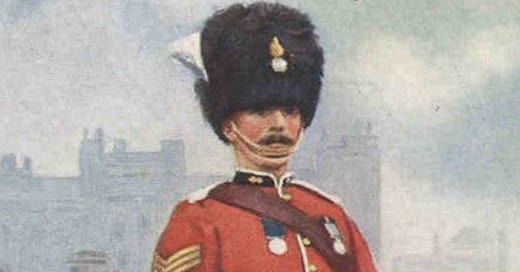This post continues the serialization of Battalion Organization, an article, published in 1912, in the Journal of the Royal United Service Institution, that argued for the replacement of the traditional eight-company battalion with a unit made up of four much larger companies. A copy of the original article can be found here, at the Military Learning Library.
Links to earlier posts in this series can be found below:
The Non-Commissioned Officer
Now let us glance for a moment at the existing situation as it affects the non-commissioned officers. Sergeants are wanted to command sections in war and they should therefore train them in peace. But, excluding color sergeants who have other duties, there are only 24 sergeants allotted to sections in peace, and nine of these are employed as follows:
Band sergeant.
Signalling sergeant.
Sergeant shoemaker.
Machine gun sergeant.
Master tailor.
Transport sergeant.
Mess sergeant.
Sergeant’s mess caterer.
Provost sergeant.
This leaves only 15 duty sergeants for the 32 sections of a battalion, but does not exhaust the list of those who are employed away from their companies. How can anyone pretend that this is a satisfactory arrangement, when the fire discipline of a section depends upon the training of its commander? I have a return before me of the section commanders of the four battalions of my brigade at the three important dates of company training, brigade training, army maneuvers (cancelled) this year, from which it appears that only 49 sergeants were actually available to train and command 128 sections.
Surely we ought to face these facts and not evade the issue? Either sergeants are wanted to command sections in war or they are not. If they are wanted they should certainly train them. How, otherwise, are they to deal with the influx of reservists who will join their sections on mobilization?
Year after year we very properly insist more and more upon the importance of section leadership, section fire control, section cohesion in the attack; we point out that modern battles may sometimes be influenced by the courageous commander of a single section, and we insist that section commanders are responsible for the lives of their men.
The modern tendency is to delegate more duties and greater responsibility to section commanders. Yet all this time we seem to ignore the simple fact that there are not half enough duty sergeants for the sections. It is a most unwise economy and one which will cost us dear in our first battle against trained Europeans. In fact, this question of section commanders should of itself suffice to compel an investigation into our peace establishments.
To be continued …
The next post in this series is:
For Further Reading:
To Share, Subscribe, or Support:










